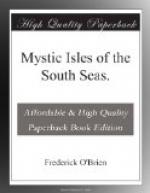I lost myself in a maze of streets, looked about for a familiar landmark, strolled a hundred paces, and found myself somewhere I thought a kilometer distant. Everywhere there are shops kept by Chinese, restaurants and coffee-houses. The streets all have names, but change them as they progress, honoring some French hero or statesman for a block or two, recalling some event, or plainly stating the reason for their being. All names are in French, of course, and many are quaint and sonorous.
As the sea-wall grew according to the demands of defense or commerce the sections were rechristened. The quai des Subsistences tells its purpose as does the quai de l’Uranie. The rue de l’Ecole and the rue de la Mission, with the rue des Remparts, speak the early building of school and Catholic church and fortifications.
Rue Cook, rue de Bougainville and many others record the giant figures of history who took Tahiti from the mist of the half-known, and wrote it on the charts and in the archives. Other streets hark back to that beloved France to which these French exiles gaze with tearful eyes, but linger all their years ten thousand miles away. They saunter along the rue de Rivoli in Papeete, and see again the magnificence of the Tuileries, and hear the dear noises of la belle Paris. They are sentimental, these French, patriots all here, and overcome at times by the flood of memories of la France, their birthplaces, and their ancestral graves. Some born here have never been away, and some have spent a few short months in visits to the homeland. Some have brown mothers, half-islanders; yet if they learn the tripping tongue of their French progenitor and European manners, they think of France as their ultimate goal, of Paris their playground, and the “Marseillaise” their himene par excellence.
One might conjure up a vision of a tiny Paris with such names in one’s ears, and these French, who have been in possession here nearly four-score years, have tried to make a French town of Papeete.
They have only spoiled the scene as far as unfit architecture can, but the riot of tropical nature has mocked their labors. For all over the flimsy wooden houses, the wretched palings, the galvanized iron roofing, the ugly verandas, hang gorgeous draperies of the giant acacias, the brilliant flamboyantes, the bountiful, yellow allamanda, the generous breadfruit, and the uplifting glory of the cocoanut-trees, while magnificent vines and creepers cover the tawdry paint of the facades and embower the homes in green and flower. If one leaves the few principal streets or roads in Papeete, one walks only on well-worn trails through the thick growth of lantana, guavas, pandanus, wild coffee, and a dozen other trees and bushes. The paths are lined with hedges of false coffee, where thrifty people live, and again there are open spaces with vistas of little houses in groves, rows of tiny cabins close together. Everywhere are picturesque disorder, dirt, rubbish, and the accrued wallow of years of laissez-aller; but the mighty trade-winds and the constant rains sweep away all bad odors, and there is no resultant disease.




